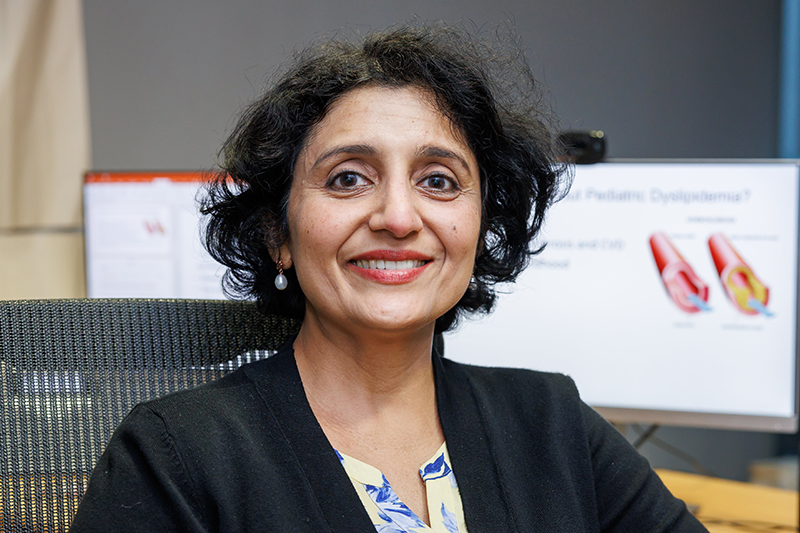
Dr. Ambika Ashraf is the director of pediatric endocrinology at Children’s of Alabama.
Through early intervention, the lipid clinic at Children’s of Alabama is aiming to give kids with lipid problems a shot at healthier adulthoods.
The clinic used to be hosted as part of the weight management clinic at Children’s until leaders realized that lipid problems are not limited to children with obesity. Ambika P Ashraf, M.D., director of pediatric endocrinology at Children’s of Alabama, runs the clinic with nurse practitioner Erin Tuanama, N.P., and pediatric endocrinologist Christy Foster, M.D. Patients also receive nutritional counseling, recommendations for physical activity and lifestyle changes and, depending on their condition, genetic and cardiology consultations. The clinic meets weekly, and the team currently follows more than 1,000 patients.
Twenty-percent of children between ages 12 and 19 have some type of lipid disorder, and that rate jumps to 42% in children who are obese.[i] Ashraf calls pediatric dyslipidemia “a no man’s land” because different pediatric subspecialists take care of children with the condition.
As the only pediatric lipid clinic in the state—and one of the largest directed by pediatric endocrinologists in the Southeast—Children’s sees patients with familial hypercholesterolemia (FH). This genetic disorder affects about one in every 250 people and dramatically increases their risk of premature heart disease. The clinic receives referrals from throughout the South and treats patients with rare, genetically linked types of dyslipidemia, such as familial chylomicronemia (FCS), severe hypertriglyceridemia, familial combined hyperlipidemia and sitosterolemia. “Lipid problems start early in childhood, and it’s very important to intervene in a timely manner to prevent the cardiovascular risk,” said Ashraf, who is board certified in lipidology and is a fellow of the National Lipid Association.
Early diagnosis is critical for early intervention, which can prevent the heart disease and stroke that dyslipidemia can bring later in life. At the clinic, patients with high triglycerides or combined dyslipidemia (high LDL and triglycerides) are primarily managed with diet and lifestyle changes. Losing just 5-10% of their body weight can normalize cholesterol levels in children with dyslipidemia resulting from obesity. Those with high LDL levels and those with FH often need medications, such as statins, and lifestyle changes.
Science proves that this early intervention can lead to a healthier adulthood. One study compared adults with FH who started a statin when they were children to their parents with FH who didn’t start a stain until middle age. Just 1% of those receiving early treatment had experienced cardiovascular events by age 39, and none had died of cardiovascular causes. Conversely, 26% of their parents had experienced cardiovascular events by age 39, and 7% had died from cardiovascular causes.
“In the past, a lot of pediatricians thought they didn’t have to treat lipid problems,” Ashraf said. “We used to think we could wait to treat these children. But we have a window of opportunity to prevent later events. We can’t wait.”
In 1991, the National Institutes of Health’s National Cholesterol Education Program recommended selective cholesterol screening of children with certain risk factors or those with FH. Twenty years later, recognizing the power of prevention and the growing epidemic of obesity in the pediatric population—which often results in dyslipidemia—the American Academy of Pediatrics (AAP) and the National Heart, Lung and Blood Institute (NHLBI) recommended universal screening for all children ages 9-11 and again between ages 17 and 21.The AAP also provided criteria for when children should see a lipid specialist versus managing the condition with diet and exercise.
The AAP and NHLBI also recommended screening children ages 2-10 if they have high-risk factors, such as parents or grandparents who had heart attacks or other cardiovascular diseases before age 55 (for men) or 65 (for women).
A recently published study found that nationally just 17% of healthy children were screened, while between 22% and 77% of children with high-risk heart conditions were screened. When Ashraf began directing the lipid clinic in 2006, only about 10-20% of local pediatricians adhered to the screening guidelines, she said. But after intensive education, including setting metrics, holding grand rounds and instituting an annual day of education, now more than half of Alabama pediatricians follow the recommended guidelines.
[i] May AL, Kuklina EV, Yoon, PW. Prevalence of Abnormal Lipid Levels Among Youths — United States, 1999—2006. MMWR. 2010; 59(02);29-33.
